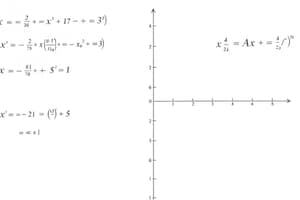Podcast
Questions and Answers
Given the equation ( y = 2x - 5), what is the slope and y-intercept?
Given the equation ( y = 2x - 5), what is the slope and y-intercept?
- slope: -5; y-intercept: (0, -2)
- slope: 2; y-intercept: (0, 5)
- slope: -5; y-intercept: (0, 2)
- slope: 2; y-intercept: (0, -5) (correct)
What is the slope of the line that passes through the points (3, 5) and (7, 13)?
What is the slope of the line that passes through the points (3, 5) and (7, 13)?
- 1
- 2 (correct)
- -2
- -1
If the equation of a line is y = 4x, what type of relationship exists between the input and output?
If the equation of a line is y = 4x, what type of relationship exists between the input and output?
- Linear
- Proportional (correct)
- Nonlinear
- Not Proportional
The equation ( 2x + y = 4 ) is in standard form. Which form would this equation be in after being converted into slope-intercept form?
The equation ( 2x + y = 4 ) is in standard form. Which form would this equation be in after being converted into slope-intercept form?
Which of the following is NOT a valid way to represent the slope of a line?
Which of the following is NOT a valid way to represent the slope of a line?
Flashcards
Slope (m)
Slope (m)
The constant rate of change between two points on a graph.
Slope-Intercept Form
Slope-Intercept Form
A linear equation in the form y = mx + b, where m is slope and b is y-intercept.
Direct Variation
Direct Variation
A relationship where y = kx, representing proportionality between x and y.
Types of Slope
Types of Slope
Signup and view all the flashcards
Graphing with y-intercept
Graphing with y-intercept
Signup and view all the flashcards
Study Notes
Slope and Graphing "Cheat Sheet"
- Slope (m): Constant rate of change, calculated using ordered pairs (x₁, y₁) and (x₂, y₂). Formula: (y₂ - y₁) / (x₂ - x₁). Used with graphs to find the "rise over run."
Slope-Intercept Form (not proportional)
- Formula: y = mx + b, where:
- 'm' is the slope
- 'b' is the y-intercept (the point where the line crosses the y-axis)
Direct Variation (proportional)
- Formula: y = kx, where 'k' is the constant of variation (same as the unit rate).
Equation Examples
- Examples of equations:
- y = 3x + 6
- y = x - 6
- -4x + y = -3
Graph Examples
- Graphing:
- Graphs illustrate the relationship between the variables (input and output) based on a given equation.
- Examples include graphs with and without y-intercepts (points where the graph crosses the y-axis) are shown.
Table Examples
- Tables:
- Tables provide numerical values for the variables (x and y).
- Examples illustrate how the proportional and non-proportional relationships can be shown in a table.
Types of Slope
- Positive Slope: The line slants upward from left to right.
- Negative Slope: The line slants downward from left to right.
- Zero Slope: The line is horizontal.
- Undefined Slope: The line is vertical.
Studying That Suits You
Use AI to generate personalized quizzes and flashcards to suit your learning preferences.




